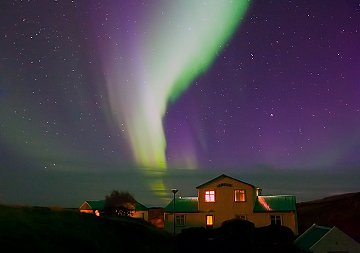 Autumn is here, and it's a wonderful time for stargazing. Find out what's up from Spaceweather PHONE.
Autumn is here, and it's a wonderful time for stargazing. Find out what's up from Spaceweather PHONE.
AURORA WATCH: A solar wind stream hit Earth on Sept. 30th, sparking bright auroras from Scandinavia to Alaska. Ívar Gudmundsson took this picture from Iceland:

Auroras also appeared over Wisconsin, Michigan and Minnesota. To the unaided eye, the display over those states was muted, but exposures of 30+ seconds with digital cameras produced some beautiful photos: aurora gallery.
Another solar wind stream is approaching Earth. More auroras are possible when it arrives on Oct. 3rd or 4th.
COMET SWAN: There's a new comet in the night sky, Comet Swan. At present, it is too dim for the naked eye, but "the comet is a spectacular sight through binoculars or a small telescope," reports Chris Schur of Payson, Arizona. In Leeds, UK, Tony Cook took this picture of Swan's sinuous tail:

Comet Swan on Sept. 30th, a 9x4 minute exposure.
Ready to see for yourself? Set your alarm before dawn; the comet rises just ahead of the morning sun. "Look behind the back leg of the Great Bear," advises Cook. "You should be able to make out a greenish fuzzball of 6th magnitude." Sky maps: Oct. 2nd, 3rd, 4th, 5th, 6th.
Good news: The comet is swinging around the sun and by the second week of October it will be visible in the evening sky at a more civilized hour. Although it is not expected to become much brighter than it is now, Comet Swan should remain an easy target for backyard telescopes for weeks to come.
more images: from Chris Schur of Payson, Arizona (9/30); from Vincent Jacques of Breil, France (9/28).

